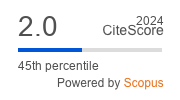The effect of interdisciplinary teamwork on creativity through knowledge heterogeneity and synthesis in a technological domain
DOI:
https://doi.org/10.23726/cij.2021.1309Keywords:
Interdisciplinary, Team, Creativity, Team Work, Divergent Phase, Brainstorming, IdeasAbstract
In this paper, creativity of students in interdisciplinary (ID) teams during the divergent (brainstorming and idea generation) phase is studied. The background of the students varied between undergraduate and graduate studies, and the creativity was stimulated amidst a discussion involving innovative solutions for the future of existing technologies In addition, the effect of knowledge heterogeneity and -synthesis is discussed. The study is conducted via a survey among the participants of the Delft/CERN IdeaSquare eSummer School 2020, held online from June 2020 to August 2020. The surveyed cohort was asked about the quantity of the generated ideas and their agreement to different statements, regarding size of the knowledge gap, effort to communicate and provide feedback, enjoyment, productivity and composition of their teams. The majority of the responding students believed they would produce the same or more ideas in ID teams, compared to that during monodisciplinary team work. We compared the agreement (between 0% and 100%) with the number of individual ideas and found a correlation for each mentioned category. This study is a first step to show that ID teams in a technological setting can be more productive. Further research should be done to repeat the experiment in a more controlled environment and solidify the hypothesis.
References
Alves, J., Marques, M.J., Saur, I. & Marques, P., 2007. Creativity and Innovation through Multidisciplinary and Multisectoral Cooperation, 16(1), pp. 27-34.
Bella, D. A., & Williamson, K. J. (1976). Conflicts in interdisciplinary research. Journal of Environmental Systems, 6(2), 105-124.
Burnet, N.G., Scaife, J.E., Romanchikova, M. et al., 2017. Applying physical science techniques and CERN technology to an unsolved problem in radiation treatment for cancer: the multidisciplinary ‘VoxTox’ research programme. CERN IdeaSquare Journal of Experimental Innovation, 1(1): pp. 3-12, https://doi.org/10.23726/cij.2017.457
Choi, B.C.K. & Pak, A.W.P., 2006. Multidisciplinarity, Interdisciplinarity and Transdisciplinarity in Health Research, Services, Education and Policy: 1. Definitions, Objectives, and Evidence of Effectiveness. Clinical and Investigative Medicine, 29(6), pp. 351-364.
Dougherty, D., 1992. Interpretive barriers to successful product innovation in large firms. Organization Science, 3(2), pp. 179–202.
Edmondson, A.C. & Harvey, J.F., 2018. Cross-boundary teaming for innovation: Integrating research on teams and knowledge in organizations. Human Resource Management Review, 28(4), pp. 347-360.
Isaksen, S.G., Lauer, K.J., Goran E. & Britz, A., 2001. Perceptions of the Best and Worst Climates for Creativity: Preliminary Validation Evidence for the Situational Outlook Questionnaire. Creativity Research Journal, (13), pp. 171-184.
King, N. & Anderson, N., 1995. Innovation and change in organizations. Routledge. London, UK.
Körner, M., 2010. Interprofessional teamwork in medical rehabilitation: a comparison of multidisciplinary and interdisciplinary team approach. Clinical Rehabilitation, 24(8), pp. 745–755.
Linsey, J.S., Green, M.G., Murphy, J.T., Wood, K.L. & Markman, A.B., 2008. Collaborating to Success”: An Experimental Study of Group Idea Generation Techniques. ASME 2005 International Design Engineering Technical Conferences and Computers and Information in Engineering Conference. California, USA, pp. 24–28.
Moraino, R., Sáncheza, M.A. & Štěpánek, L., 2020. Creative interdisciplinary collaboration: A systematic literature review Thinking Skills and Creativity, 35.
Newell, W., 2007. Handbook of Decision Making, 1st. Chapter 13: Decision Making in Interdisciplinary Studies, pp. 245- 264. CRC Press/Taylor & Francis Group. Pennsylvania, USA.
Nijstad, B.A., Stroebe, W, Lodewijkx, H.F.M., 1999. Persistence of Brainstorming Groups: How Do People Know When to Stop?. Journal of Experimental Social Psychology, Volume 35, Issue 2, pp. 165-185, https://doi.org/10.1006/jesp.1998.1374
Parjanen, S. & Hyypiä, M., 2019. Innotin game supporting collective creativity in innovation activities. Journal of Business Research, 96, pp. 26-34.
Pennington, D., 2016. A conceptual model for knowledge integration in interdisciplinary teams: orchestrating individual learning and group processes. Journal of Environmental Studies and Sciences, 6, pp. 300-312.
Tang, M. & Werner, C.H., 2017. An interdisciplinary and intercultural approach to creativity and innovation: Evaluation of the EMCI ERASMUS intensive program. Thinking Skills and Creativity, 24, pp. 268-278.
Wenger, E., 2000. Communities of Practice and Social Learning Systems. Organization, 7(2), pp. 225-246.
Downloads
Additional Files
Published
How to Cite
License
Copyright (c) 2021 Jelmer Mulder, Saraf Nawar, Joelle De Groot, Marco Zambello

This work is licensed under a Creative Commons Attribution 4.0 International License.
Authors who publish with this journal agree to the following terms:
- Authors retain copyright and grant the journal right of first publication with the work simultaneously licensed under a Creative Commons Attribution License that allows others to share the work with an acknowledgement of the work's authorship and initial publication in this journal.
- Authors are able to enter into separate, additional contractual arrangements for the non-exclusive distribution of the journal's published version of the work (e.g., post it to an institutional repository or publish it in a book), with an acknowledgement of its initial publication in this journal.
- Authors are permitted and encouraged to post their work online (e.g., in institutional repositories or on their website) prior to and during the submission process, as it can lead to productive exchanges, as well as earlier and greater citation of published work (See The Effect of Open Access).


